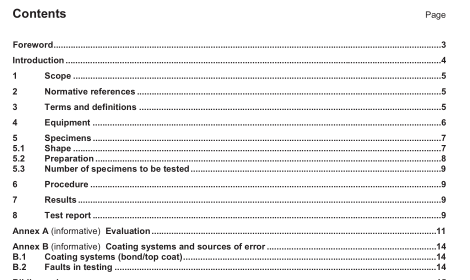BS EN 15340:2007 – Thermal spraying — Determination of shear load resistance of thermally sprayed coatings

1 Scope
This European Standard specifies the procedure for determination of the shear load resistance of thermally sprayed coatings, provided that a minimum thickness is given.
Additionally this European Standard defines the shear load resistance and the designation of the fracture’s structure on the test specimen, which occurs when the shear adhesive or adhesive/ cohesive or cohesive strength of the coating or the coating system will be exceeded.
The test report is the basis for comparative statements regarding shear load resistance and structure of fracture.
NOTE The test for the determination of the shear load resistance is not recommended for sprayed coatings thinner than approximately 150 µm because the adjustment of shear distance becomes critical.
2 Normative references
The following referenced documents are indispensable for the application of this document. For dated references, only the edition cited applies. For undated references, the latest edition of the referenced document (including any amendments) applies.
EN 657:2005, Thermal spraying — Terminology, classification
EN ISO 7500-1, Metallic materials — Verification of static uniaxial testing machines — Part 1: Tension/compression testing machines — Verification and calibration of the force-measuring system (ISO 7500-1:2004)
ISO 1832, Indexable inserts for cutting tools — Designation
3 Terms and definitions
For the purposes of this document, the terms and definitions given in EN 657:2005 and the following apply.
3.1
shear strength
FSa
maximum force that causes fracture of the specimen in the interface coating/substrate
NOTE This fracture mode is called “Mode 1”.
3.2
shear adhesive/cohesive strength
FSa/c
maximum force that causes mixed fracture partially within coating material and partially in the interface coating/substrate
NOTE This fracture mode is called “Mode 2”.
3.3
shear cohesive strength
FSc
maximum force that causes fracture of the specimen within the coating material
NOTE This fracture mode is called:
•
“Mode 3a”
– if in case of hard coatings continuous blistering of small or larger pieces of the coating occurs;
– if soft and/or porous coatings will be compressed and continuously scraped off;
• “Mode 3b”
– if the fracture path runs within the coating especially parallel to the interface coating/substrate and the coating part under the shear plate detaches in one piece
3.4
shear energy
ES
area below the force displacement curve provided by the shear test
NOTE The energy ES up to the first shear force maximum can be calculated using the force-displacement curve provided by the shear test. The energy ES relates to the energy absorption of the coating-substrate system until failure.
3.5
shear distance
d
distance between interface coating/substrate and the edge of the shear plate
3.6
shear load resistance
value of the first maximum of the load during the shear test process
4 Equipment
The shear test may be performed using a universal testing machine in accordance with EN ISO 7500-1 class 2.5 or using stand alone desk top machine which fulfils the corresponding requirements for accuracy and reproducibility.
The construction of the testing machine shall be able to apply a force required for the operation. The principle of the testing set up is demonstrated in Figure 1.
BS EN 15340:2007 – Thermal spraying — Determination of shear load resistance of thermally sprayed coatings